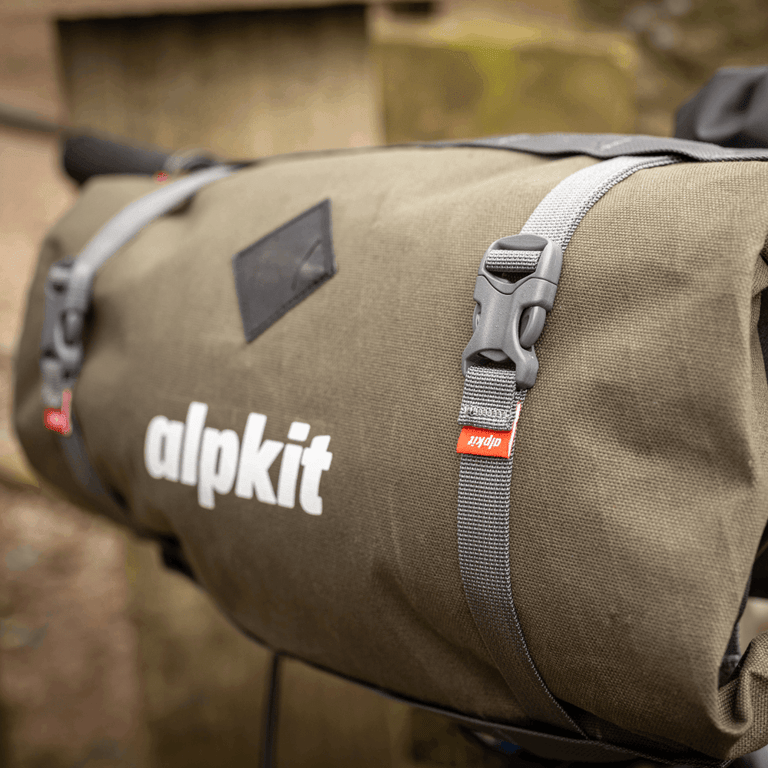
Prepare for multi-day bikepacking adventures with a comprehensive kit list.
The Highland Trail is a 560 mile, long-distance, self-supported mountain bike time-trial route through the Scottish Highlands. It’s a tough and gruelling endurance event that takes a special ‘type 2 fun’ enthusiast to get through it.
Multi-day adventures can be incredibly satisfying and a great way to get off the beaten track. The Highland Trail 550 is a great example of this. It can be completed as a time trial during a mass start over the May bank holiday, or simply head up whenever you manage to get some time off work!
Generally speaking, people finish the time trial in 4-8 days, covering 100+ miles of rough terrain per day, with little to no sleep (planning is key).
It's a tough challenge, but when you're riding for days in the Scottish Highlands, it's easy to see why people return year after year.
What Pete packs, in a nutshell
With the likes of the HT550, Silk Road Mountain Race and Transcontinental becoming more popular, we wanted to know what it takes to take part in these multi-day challenges as well as heading out on our own long-distance trips.
We asked Adventure Pedlar, Alpkiteer and HT550 Veteran Pete McNeil about the route, and what he packs.
With this long-distance bikepacking kit list, you'll get an in depth insight into what to pack for the HT550, and get an idea of where to start for even longer adventures.
- In the video, Pete covers:
-
The Highland Trail 550: what to expect
-
HT550 route details
-
HT550 terrain details
-
-
Bike check – choose a bike that's right for you
-
Bike luggage and the kit it carries
- Handlebar bags for emergency gear and sleep system
- Cockpit bags for snacks, energy gels and electricals
- Frame bag for heavier items: tools and cooking equipment
- Saddle bag for warm, dry clothes and spare socks
- A bumbag (or small hydration pack) for water and waterproofs
-
Figure out your own process for packing
The Highland Trail 550: what to expect
The HTT550 is a committing ride. There’s no entry fee, no prize money, simple rules and definitely no support - you’re on your own for the duration.
Okay, so not completely on your own! You do get a suggested start time, a GPS track file, a list of completion times and the route takes you through a few towns at which you can refuel and resupply.
For a lucky 40, there’s company in the mass start on the last bank holiday in May, but you can ride it any time you want as an ITT (individual time trial). And ‘unsupported’ means there’s no one there to rescue you should it all go wrong.
- HT550 Route Details
Learn the route. Plan your ride to take enough supplies per section, and know where to resupply.
Starting at Tyndrum, the route heads North, traversing Ben Alder to reach the crucial pizza collection point at Fort Augustus.
Northwards still, you'll pass the stores in Contin, the last resupply before venturing off into the remote northern loop around Assynt.
From here, the journey takes riders South towards some incredible Scotch pies at Lochinver Larder (closes at 9pm, plan wisely). Then it’s down to the Oykel Hotel and on to Ullapool before the wild and remote Fisherfield crossing.
The next resupply point is at the Whistle Stop café, or the village shop in Kinlochewe. A good feed here will prepare you for one of the most technical sections of the route: Achnashellach, Torridon.
On through Dornie, a quick stop at the café or shop and into Glen Affric before visiting Fort Augustus for the second time (and getting a second pizza – why not ey?).
A fast blast down the Great Glen Way into the relative civilisation and bright lights of Fort William. Finally, riders push on south to Kinlochleven and over the Devil’s Staircase for the last dash to the finish.
- HT550 Terrain Details
Weather can drastically alter the terrain, and kit you take. Check what the weather is doing in the weeks before, not just the 'on the day' forecast.
May bank holiday in Scotland: there’s a chance of midge-free riding, but weather really is unpredictable. Riders have to prepare for rain, snow, sunshine, and anything else the elements can throw at them.
Technical descents, long hike-a-bikes, deep bogs, river crossings and minimal resupply points mean that any attempt must be carefully considered and kit packed according to possible conditions and intended time frames.
The HT550 is the kind of ride that will quickly highlight the strengths and weaknesses in your systems and preparation.


Bike Check – choose what’s right for you
Folks ride the Highland Trail on all kinds of different bikes. You see drop barred ‘adventure bikes’, all the way through to full suspension trail bikes. It all comes down to your style of riding, how comfortable you want to be and which sections you want to make the time up on.
Pete opted for a Sonder Transmitter. Because Pete comes from a background of mountain biking on UK trails, the more aggressive geometry on the Transmitter suited his ability to make up time on the technical sections and rugged terrain. A dropper seatpost also made for quicker and more controlled descents.
It all comes down to your personal style of riding, Tom and Rich Seipp have ridden the HT550 several times on Sonder Frontiers, and Stu Taylor went for a Sonder Broken Road, so just choose a bike that’s right for you and the ground you’re taking it on.

Bike luggage and the kit it carries
Getting the right bikepacking set-up for any bikepacking trips can make or break your experience.
Pete's an experienced endurance racer, with a minimalist setup that he's fine tuned over the years to balance a fast and light approach with enough comfort to enjoy the ride.
Be honest with yourself. How long is it likely to take you? How comfortable do you want to be? Then pack accordingly.
- Handlebar bags for emergency gear and sleep system
Pete chose the Tivaro 13L dual ended handlebar bag. It’s tough and waterproof, which are two crucial elements when you’re on a self-supported bikepacking adventure in the Scottish Highlands.
Pete uses a large Roo Pouch on top for added storage.
In the Roo Pouch - maps and emergency kit:
(approx 0.5kg)
-
Route overview map
-
First aid kit for bumps and scrapes
-
Mosquito repellent (pesky midges!)
-
Back-up maps (in case the GPS fails)
In the Tivaro - sleeping kit:
(approx. 2.5kg)
-
Rig 3.5 tarp (with Fredd 4 guy lines in situ)
-
Silk sleeping bag liner


- Cockpit bags for snacks, energy gels and camera kit
The cockpit is all about accessibility. Things you'll need to keep you going without having to stop.
You're not going to be eating 3 square meals a day on a fast paced bikepacking adventure, so high calorific snacks (like a fruit and nut mix) to get you through the day are a must.
Pete’s advice for food - don’t overpack!
“The reality of covering bigger distances is that you’re more likely to come across shops and places where you can buy stuff. Take less and replenish.”
Pete uses a Stem Cell and Fuel Pod 22 to pack:
(approx. 1.5kg)
-
Sonder Confucius handlebars
-
GPS navigation device
-
Hadron bike light (with battery pack in the frame bag)
-
Swig 500ml water bottle for rehydration tablets (whilst a separate bladder carries fresh water)
-
High calorie snacks
-
Electricals (phone, camera, iPod etc - charged via a dynamo hub)



- Frame bag for heavier items: tools and cooking equipment
Using a custom built Stingray from tough VX21 fabric, Pete leaves space for a spare inner tube taped in at the top of the down tube.
With a horizontal divider in the Stingray, Pete separates heavier kit, with bike spares and tools in the bottom half, and his cooking system up top.
Here’s what Pete packs in his Stingray Frame Bag:
(approx. 2.8kg)
-
A Leatherman style multitool with plyers and a knife
-
A pump wrapped in gaffa tape (because there’s nothing you can’t fix with a bit of gaffa tape)
-
A multitool for bike repairs
-
Bike spares - inner tube, brake pads, tyre boots, rubber bands, jubilee clips, spokes and lube
-
Patch kit for the Numo sleeping mat
-
Boson bike light (adapted for Pete’s helmet)
-
Zip ties
-
Bulky food like dehydrated meals (one per day you're expecting to be riding, and/or plan resupply points)
-
100g gas canister
-
A selection of tea bags, coffee and rehydration tablets
-
Midge head-net (always a must!)
-
Lampray (provides light and power for the phone and iPod)
- Saddle Bag for Warm, Dry Clothes and Spare Socks
Using the Exo-Rail means Pete could use a Koala 7L seat pack whilst still making full use of the dropper post over technical sections.
Plus, reducing sway means the Exo-Rail makes for a more comfortable ride.
Here’s what Pete packs in his saddle bag:
(approx. 2kg)
-
2 x Airlok dry bags
-
Katabatic Primaloft insulated jacket (Mens Katabatic | Womens Katabatic)
-
Emergency food rations (2 x Firepot Meals)
-
Toothpaste and toothpaste
- A Bumbag (or small hydration pack) for water and waterproofs
Let your bike do the work. The best option is to not wear a bumbag or rucksack at all.
Pete uses a bumbag to hold a 2l water bladder and waterproof jacket. Anything you're carrying on your body is more likely to slow you down, so keep it light.
If a bumbag doesn’t suit you, something like the Artlu 10l hydration vest works for long days in the saddle. It's minimal and lightweight with a hydration port, and easily accessible.
Here’s what Pete packs in his bumbag:
(approx. 2.8kg with a full bladder)
-
Gravitas lightweight waterproof jacket (Mens Gravitas | Womens Gravitas)
-
Hydration system – Hippo water filter and 2 litre Bota water bladder (taking a water filter offers more options for refilling)
-
Arm warmers
Figure Out Your Own Process for Packing
Everyone’s got their different way of doing things, and for me it’s kind of a dynamic process. I’m going to be keeping an eye on the weather forecast right up until the point I get in my van to drive up there.
I know there’ll be people that go with a lighter weight setup, and I know there’ll be people that go with more kit and a heavier setup. Really, for me, it’s all about trying to find that balance. Ultimately, the thing which I love about the Highland Trail is that it’s proper hard, technical mountain bike riding in places, so for me as a mountain biker, I want to enjoy that riding. I want it to bring a smile to my face, so I’ll take any kit I can go with that helps me enjoy the trail, rather than seeing it as some kind of brutal self-punishment. I hopefully will go and just enjoy riding in Scotland for a few days." - Pete McNeil, 2018
Our Top 5 Tips for Long Distance Bikepacking
- Learn the route - knowing when and where to resupply can help minimise the food you pack.
- Plan your sleep - know where you're stopping and for how long to help minimise your sleep system.
- Use a dynamo hub - keep your GPS gong for route info and your phone charged for emergencies.
- Pack smart snacks - don't overpack; take high-calorie snacks like nuts and resupply.
- Let the bike do the heavy lifting - carry as little as you can on your back.






































